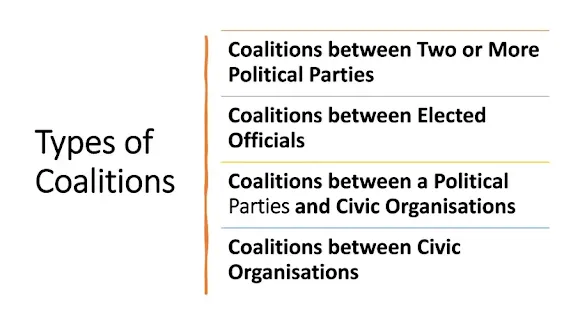Table of Contents:
Coalition Meaning
A coalition is a temporary partnership between two or more people, militaries, states, factions, political parties, or other parties, to gain more influence or power than the individual groups or parties can hope to achieve on their own.
By focusing on their common objectives and goals, all of the member groups can build their strength and advantage on their common interest. With a particular objective in mind – passing a particular piece of legislation, winning an election, or forming a government – coalitions have a limited life span until the objectives are fulfilled.
All of the partners should feel as though they are succeeding or accumulating something out of the coalition – a winning situation.
Types of Coalitions
Different types of coalitions can play a role in politics:

1) Coalitions between Two or More Political Parties: Political parties may agree to work together to increase their profits in upcoming elections or support themselves in the legislative area.
2) Coalitions between Elected Officials: Elected officials may agree to work together or at the least not oppose one another for mutual benefit. These coalitions may be politicians from a particular region or blocs of political parties in a legislative body that agree to work together towards a certain goal.
3) Coalitions between a Political Party and Civic Organisations: Civic organisations may form coalitions with political parties to assist the political party and advance their particular agenda.
4) Coalitions between Civic Organisations: Civic organisations may agree to combine forces in the political arena to affect the outcome of an election or vote on a particular piece of legislation.
Benefits of Coalition
The benefits of coalition building go beyond increased power over the opposition. Team building may also strengthen the members internally, allowing them to be more influential in other areas.
Some key advantages to coalition-building include:
1) A partnership of organisations can win on more fronts than a single organisation working alone and increase the potential for success.
2) A coalition can bring more expertise and resources to bear on complex issues, where the technical or personnel resources of any one organization would not be sufficient.
3) A coalition can develop new leaders. As trained group leaders step forward to lead the coalition, openings are created for new leaders in the respective groups. The new, rising leadership boosts the group behaviour and the partnership.
4) A coalition will increase the impact of each organisation’s effort Involvement in a coalition means more people have a better understanding of your issues and more people advocating for your side.
Some more key advantages to coalition-building include:
5) A coalition will increase available resources. Not only will financial and physical resources be increased, but each group will gain access to the connections, contacts, and relationships established by other groups.
6) A coalition may raise its members’ public profiles by broadening the range of groups involved in a conflict. The activities of a coalition are likely to receive more media attention than those of any particular organisation.
7) A coalition can build a lasting base for change. Once groups unite, each group’s idea of change widens and it becomes more difficult for opposition groups to disregard the coalition’s efforts as dismissible or as special interests.
8) A successful coalition is made up of people who have never worked together before. Coming from various backgrounds and different viewpoints, they have to figure out how to respect each other’s differences and get something big accomplished. They have to figure out how each group and its representatives can make different but valuable contributions to the overall strategy for change. This helps to avoid duplication of efforts and improve communication among key players.
Limitations of Coalition
Various limitations of working in a coalition are as follows:
1) Member groups can get distracted from other work. If that happens, non-coalition efforts may become less influential and the organisation may be weakened overall.
2) A coalition may only be as strong as its most fragile connection. Each member of an organisation will have different levels of experience and resources as well as different interior problems. Organisations that provide a lot of resources and leadership may get frustrated with other members’ shortcomings.
3) To keep a coalition together, it is often required to cater to one side more than another, mainly when negotiating tactics. If fellow members choose high-profile confrontational tactics, they may dislike subdued tactics, thinking they are not exciting enough to mobilise support. At the same time, the low-profile, conciliatory partners might be alarmed by the confrontation advocates, fearing they will escalate the conflict and make eventual victory more difficult to obtain.
4) The democratic principle of one group one vote may not always be acceptable to members with a lot of power and resources. The coalition must carefully define the connections between effective and less effective groups.
5) Individual organisations may not get credit for their contributions to a coalition. Members who contribute a lot may think that they do not receive enough credit.
You May Also Like:-
Nature of Organisational Behaviour
Conceptual Foundation of Organisational Behaviour
Contributing Disciplines to organisational behaviour
Models of Organisational Behaviour
Approaches of Organisational Behaviour
Emotional Intelligence in Organisational behaviour
Factors Influencing Perception
Scope of Organisational Behaviour
Importance of Organisational Behaviour
Challenges and Opportunities of Organisational Behaviour
Factors affecting group behaviour
Causes of Conflict in an Organisation
Types of Conflict in an Organisation
Organisational Development Process
Factors Affecting Organisational Culture
Trait Theory: Stogdill’s trait factors
Transactional Analysis in organisational behaviour
